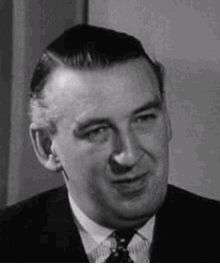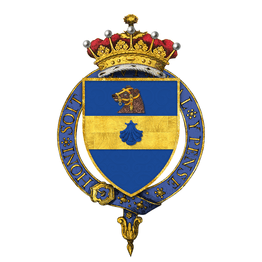Rowland Baring, 3rd Earl of Cromer
Lieutenant-Colonel George Rowland Stanley Baring, 3rd Earl of Cromer, KG GCMG MBE PC (28 July 1918 – 16 March 1991), styled Viscount Errington before 1953, was a British banker and diplomat. After serving during the Second World War, he was Governor of the Bank of England (1961–1966) and British Ambassador to the United States (1971–1974).
Lieutenant-Colonel The Right Honourable The Earl of Cromer | |
|---|---|
 | |
| British Ambassador to the United States | |
| In office 1971–1974 | |
| Monarch | Elizabeth II |
| President | Richard Nixon Gerald R. Ford |
| Prime Minister | Ted Heath Harold Wilson |
| Preceded by | John Freeman |
| Succeeded by | Peter Ramsbotham |
| Governor of the Bank of England | |
| In office 1 July 1961 – 30 June 1966 | |
| Preceded by | The Lord Cobbold |
| Succeeded by | Sir Leslie O'Brien |
| Personal details | |
| Born | George Rowland Stanley Baring 28 July 1918 |
| Died | 16 March 1991 (aged 72) London, England |
| Nationality | British |
| Alma mater | Trinity College, Cambridge |
| Occupation | Banker, diplomat |
| Military service | |
| Allegiance | United Kingdom |
| Branch/service | British Army |
| Years of service | 1938–1948 |
| Rank | Lieutenant-Colonel |
| Unit | Grenadier Guards |
| Battles/wars | Second World War |
| Awards | Knight of the Order of the Garter Knight Grand Cross of the Order of St Michael and St George Member of the Order of the British Empire |

Early life and military career
A member of the Baring family and the eldest son of the 2nd Earl of Cromer and his wife Ruby Elliot-Murray-Kynynmound, he was educated at Eton and Trinity College, Cambridge, where he left after a year. He served with the Grenadier Guards during the Second World War, where he gained the rank of Lieutenant-Colonel and became a Member of the Order of the British Empire.[1]
Banking and diplomatic career
After serving as private secretary to Freeman Freeman-Thomas, 1st Marquess of Willingdon in 1938, he joined Barings Bank, founded by his ancestor Sir Francis Baring, as a clerk. After military service during the war, he was managing director of Barings between 1949 and 1959. He then served as Economic Minister at the British Embassy in Washington as well as holding executive directorships at the International Monetary Fund, the International Bank for Reconstruction and Development, and the International Finance Corporation.
He was appointed Governor of the Bank of England in 1961, a position he held until 1966. During his governorship he clashed with the incoming Labour Prime Minister Harold Wilson, over Cromer's desire to see government spending contained, which may have contributed to his decision not to seek a second term. Cromer was subsequently appointed to the Privy Council. He was responsible for the Cromer Report into Lloyd's of London.
From 1971 to 1974 he served as British Ambassador to the United States. Following his appointment he became a Knight Commander of the Order of St Michael and St George,[2] and was raised to the rank of Knight Grand Cross in 1974.[3] He was a Governor of the pro-NATO Atlantic Institute and a member of the Pilgrims Society executive committee.
In 1977, he was made a Knight of the Garter.[4]
Personal life
Cromer married Hon. Esme Mary Gabriel Harmsworth (1922–2011) in 1942, daughter of Esmond Harmsworth, 2nd Viscount Rothermere. At their wedding she walked barefoot down the aisle in order to avoid appearing taller than the best man.[5]
They had three children:
- Lady Lana Mary Gabriel (1943–1974)
- Evelyn Rowland Esmond (born 1946), who succeeded as 4th Earl of Cromer
- Hon. Vivian John Rowland (born 1950), married his second cousin Lavinia Baring.
Both the Countess of Cromer and her daughter-in-law were royal attendants. Esme Harmsworth was a Lady of the Bedchamber to Queen Elizabeth II, while Lavinia Baring was a Lady-in-Waiting to Diana, Princess of Wales.[6]
In 1964, during the period he was at the Bank of England, Cromer purchased a Fairey Huntsman 28 sports cruiser from Fairey Marine, Hamble. Bearing the name Le Reve, the vessel was taken to France. The boat still exists, and details can be seen on the Fairey Owners Club[7] website.
The 3rd Earl died on 16 March 1991 in London. Esme remarried in 1993 to Gerrit van der Woude.
Footnotes
- "No. 36917". The London Gazette (Supplement). 30 January 1945. p. 673.
- "No. 45308". The London Gazette. 19 February 1971. p. 1527.
- "No. 46162". The London Gazette (Supplement). 28 December 1973. p. 3.
- "No. 47207". The London Gazette. 26 April 1977. p. 5631.
- This should cite her biography From This Day Forward, 1991, p. 4, which is incorrectly quoted in the Daily Mail article.Wilkes, David (9 June 2011). "Esme, Dowager Countess of Cromer, dies". Daily Mail. London.
- "Yvonne's Royalty Home Page: Diana, Princess of Wales' Ladies-in-Waiting". Users.uniserve.com. Retrieved 31 March 2016.
- "Huntsman 28 - The Fairey Marine Hull Production Archive". Sites.google.com. 29 June 2011. Retrieved 31 March 2016.
References
- Orbell, John (January 2008). "Baring, (George) Rowland Stanley, third earl of Cromer (1918–1991)". Oxford Dictionary of National Biography (online ed.). Oxford University Press. doi:10.1093/ref:odnb/49616. Retrieved 4 November 2009. (Subscription or UK public library membership required.)
- "Cromer, 3rd Earl of". Who Was Who. A & C Black; Oxford University Press (online edition). December 2008. Retrieved 4 November 2009.
External links
- Hansard 1803–2005: contributions in Parliament by the Earl of Cromer
| Court offices | ||
|---|---|---|
| Preceded by Jock Colville |
Page of Honour 1931–1935 |
Succeeded by George Seymour |
| Government offices | ||
| Preceded by The Lord Cobbold |
Governor of the Bank of England 1961–1966 |
Succeeded by Sir Leslie O'Brien |
| Diplomatic posts | ||
| Preceded by John Freeman |
British Ambassador to the United States 1971–1974 |
Succeeded by Sir Peter Ramsbotham |
| Peerage of the United Kingdom | ||
| Preceded by Rowland Baring |
Earl of Cromer 1953–1991 |
Succeeded by Evelyn Baring |